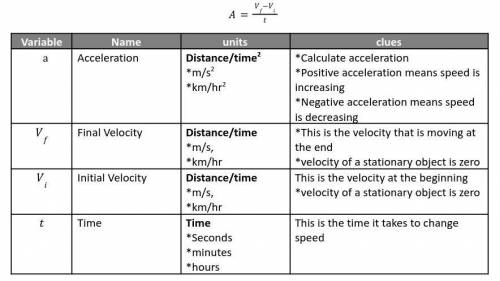
Physics, 26.10.2021 14:00 dulldiamondss2858
An object traveling 200 feet per second slows to 50 feet per second in 5 seconds. Calculate the acceleration of the object.
Variable
Equation
Solve


Answers: 2


Other questions on the subject: Physics

Physics, 21.06.2019 15:30, Isabelcastillox1085
Match the atomic particles with their characteristics. 1. made of two protons and two neutrons neutron 2. similar to an electron; positive charge neutrino 3. orbits nucleus; negative charge positron 4. bundle of energy; zero charge proton 5. found in nucleus; positive charge meson 6. very unstable; +, -, or zero charge gamma 7. found in nucleus; zero charge electron 8. negative particle; negative charge beta 9. atomic energy converted to mass alpha
Answers: 1



Physics, 22.06.2019 19:30, rprest00
Amass m = 74 kg slides on a frictionless track that has a drop, followed by a loop-the-loop with radius r = 18.4 m and finally a flat straight section at the same height as the center of the loop (18.4 m off the ground). since the mass would not make it around the loop if released from the height of the top of the loop (do you know why? ) it must be released above the top of the loop-the-loop height. (assume the mass never leaves the smooth track at any point on its path.) 1. what is the minimum speed the block must have at the top of the loop to make it around the loop-the-loop without leaving the track? 2. what height above the ground must the mass begin to make it around the loop-the-loop? 3. if the mass has just enough speed to make it around the loop without leaving the track, what will its speed be at the bottom of the loop? 4. if the mass has just enough speed to make it around the loop without leaving the track, what is its speed at the final flat level (18.4 m off the ground)? 5. now a spring with spring constant k = 15600 n/m is used on the final flat surface to stop the mass. how far does the spring compress?
Answers: 3
You know the right answer?
An object traveling 200 feet per second slows to 50 feet per second in 5 seconds. Calculate the acce...
Questions in other subjects:


History, 17.09.2019 08:00



History, 17.09.2019 08:00


Chemistry, 17.09.2019 08:00



Computers and Technology, 17.09.2019 08:00



